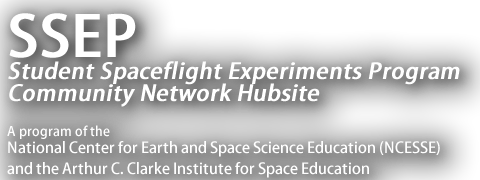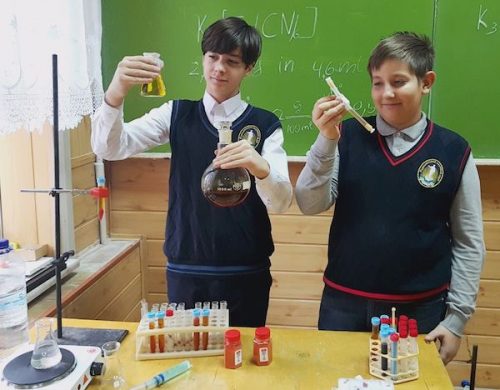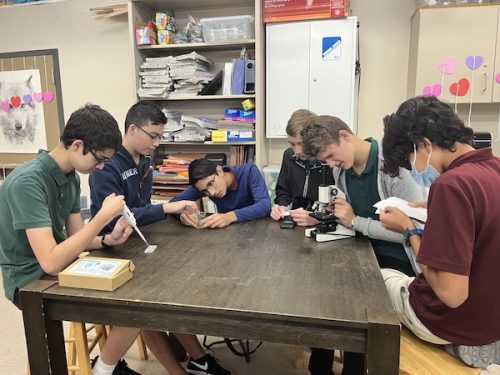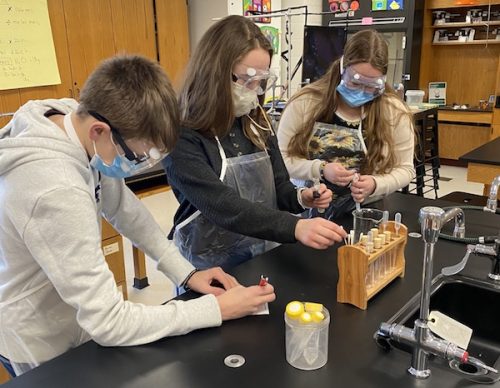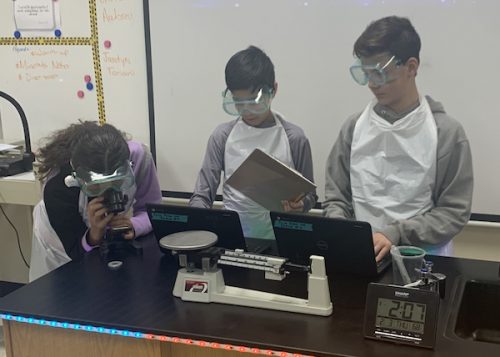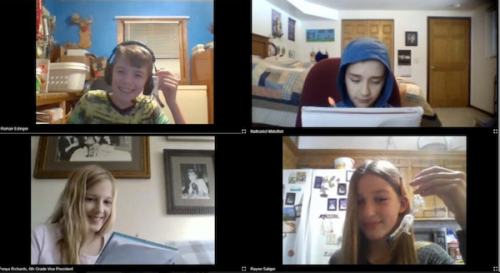Last update of this page: January 31, 2023, 3:13 pm ET
COVID IMPACT: Due to the impact of the COVID-19 pandemic SSEP Mission 16 to the International Space Station (ISS) was split into Mission 16A and 16B. 19 communities (21 flight experiments) followed the original SSEP Mission 16 Critical Timeline (16A), while 3 communities (3 flight experiments) that were severely impacted by the pandemic followed an alternate Mission 16 Critical Timeline (16B). Due to the timing of the launch, all Mission 16 flight experiments and mission patches will be flown together and referred to as SSEP Mission 16 to ISS.
The Student Spaceflight Experiments Program is proud to report that there were a total of 1,262 proposals submitted from student teams across the 22 communities participating in Mission 16 to ISS. Of those, 539 proposals were forwarded for review by Step 1 Review Boards in each of the communities. Each Step 1 Review Board selected up to three finalist proposals, which were submitted to the National SSEP Step 2 Review Board.
On November 30, 2021 the Mission 16A Step 2 Review Board met via Zoom and reviewed all 61 finalist proposals, and selected one proposed experiment to fly for 17 communities and two proposed experiments for two communities, for a total of 21 flight experiments. By December 16, 2021, the National Center for Earth and Space Science Education and the Arthur C. Clarke Institute for Space Education formally notified each community of their selected flight experiments.
On May 10, 2022 the Mission 16B Step 2 Review Board met via Zoom and reviewed all 9 finalist proposals, and selected one proposed experiment to fly for 3 communities, for a total of 3 flight experiments. By May 25, 2022, the National Center for Earth and Space Science Education and the Arthur C. Clarke Institute for Space Education formally notified each community of their selected flight experiments.
It is noteworthy that the 1,262 proposals received reflected a total of 6,497 grade 5-16 students fully engaged in experiment design.
All 70 finalist experiment teams, along with descriptions of their proposed flight experiments, are provided below. You are also invited to meet the SSEP Step 2 Review Board members for Mission 16 to ISS.
Congratulations to the over 6,400 students and their teachers participating in Student Spaceflight Experiments Program Mission 16 to the International Space Station.
Quickly Scroll to Individual Communities
- Ukraine
- Coquitlam, British Columbia, Canada
- Moreno Valley, California
- Perris, California
- Redlands, California
- Hillsborough County, Florida
- Ocala, Florida
- Lake Charles, Louisiana
- University System of Maryland, Maryland
- Grand Blanc, Michigan
- Hoboken, New Jersey
- Albany, New York
- Buffalo/Niagara, New York
- Garden City, New York
- Norwood, New York
- Pickerington, Ohio
- Bandera, Texas
- Burleson, Texas
- Ector County, Texas
- Texarkana, Texas
- Bellingham, Washington
- iForward-Grantsburg, Wisconsin
1. Ukraine
Jump to Ukraine’s Community Profile
SELECTED FOR FLIGHT:
Dental Filling Material Solidification in Microgravity Conditions
Grade 11, Kharkiv gymnasium № 47 in collaboration with Junior Academy of Sciences of Ukraine
Co-Principal Investigators: Harkavets Mykhailo, Volkov Vladyslav
Co-Investigators: Davydova Sofiia, Sadchykova Yelvzaveta
Teacher Facilitator: Savoilov Andrii
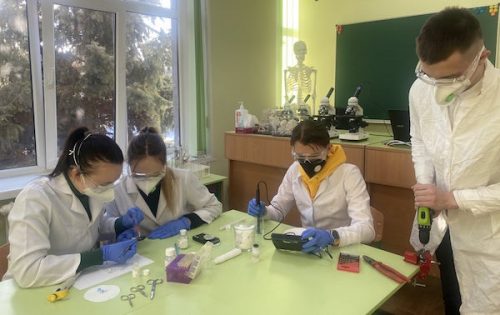
Students Researchers from Kharkiv working on the preparation of the selected flight experiment, dental filling material solidification in microgravity conditions.
Proposal Summary:
The main question addressed by this paper is: how microgravity affects dental restorative material adhesion and structure. Dental problems are widespread on the Earth, but they may become even more dangerous in space. Such problems are known to happen on the ISS. There were cases when astronauts made luting indirect restoration of his tooth to prevent further tooth destruction until he returned to the Earth (Menon A., 2012; Aldredge W., 2016). In any case, dental problems are inevitable, even considering the possibility of astronaut screening by tooth health. The main reason is insufficiently evoking of enamel and dentin restoration process due to the softness of astronaut food. Thus, decalcification occurs, and teeth become brittle. Therefore, dental operations will be needed in space, especially in long- term flights to other planets. The experiment will show any difference between filling materials prepared in space and on the Earth. Henceforth, the research will show microgravity effects on filling`s integrity, homogeneity, strength, and adhesion to the teeth.
The Effects of Microgravity on Potassium Hexacyanoferrate(III) Crystals
Grade 8, Communal Institution, Richelieu Scientific in collaboration with Junior Academy of Sciences of Ukraine
Co-Principal Investigators: Hryb Andrii, Skrypnyk Nikita
Teacher Facilitator: Anastasiia Maskechko
Proposal Summary:
This proposal relates to the problem of crystal growth under microgravity conditions. The main goal is to study the effect of microgravity on the crystal’s shape and volume during its growth. Another aim is to develop a proper algorithm for crystallization in microgravity and a confined vessel. As an object of the investigation, potassium hexacyanoferrate (III) crystals are chosen for their rich color and distinct shape. Under the typical conditions on the Earth’s surface, its monocrystals grow red and rod-shaped. It is hard to expect to see a monocrystal in this experiment. However, a difference in shape and size still will be observed. It is expected to have a much slower growing process and smaller samples in space compared to earth conditions.
HONORABLE MENTION FINALISTS:
The Role of Peroxisomes in the Metabolism of Phospholipids in Microgravity
Grade 11, Ukrainian Physics and Mathematics Lyceum of Taras Shevchenko Kyiv National University in collaboration with Junior Academy of Sciences of Ukraine
Principal Investigator: Arkhyp-Volodymyr Oliinyk
Investigator: Taras Sachenko
Collaborator: Vladyslav Kushch
Teacher Facilitator: Reshetnik Yevdokiia
Proposal Summary:
The latest studies dedicated to the influence of microgravity on a person show that in the blood of the astronauts, who were in the Earth orbit for a long time, some biomarkers of the injured brain were detected. Our team established in theory that peroxisomes play a considerable role in informing white matter of the brain at a particular moment. Therefore, the main goal of our investigation is to discover the functioning of peroxisomes on the example of yeasts that will develop in the micro-g environment for a while to model a situation in a human cell as our next step. The received results will give us a possibility to make conclusions about the microgravity influence on defections of the correct work of peroxisomes and, respectively, whether they are the actual cause of injuring the brain’s nerve tissue.
Antimicrobial Properties of Retinoid CD437 against Staphylococcus aureus in Microgravity Conditions
Grades 9 and 11, Municipal Institution “Mariupol Technical Lyceum” of Mariupol City in collaboration with Junior Academy of Sciences of Ukraine
Co-Principal Investigators: Artemenko Danylo, Kolomiychuk Daria
Investigator: Animitsa Hanna
Collaborator: Lenskaya Alina, Metik Maria
Teacher Facilitator: Viacheslav Ponomarchuk
Proposal Summary:
The problem of pathogenic bacteria adapting to the action of medicine will always be very relevant because they constantly form various resistant forms that can cause much trouble, especially when it comes to residential orbital complexes located at a distance from Earth. The search for new effective means to counteract potentially dangerous forms of bacteria is one of the main tasks of modern medicine, both on Earth and in near-Earth space, where people live and work. The main goal of this proposal is to investigate the ability of retinoid CD437 to harm the growth of Staphylococcus aureus colonies. Approximately one-third of the population has Staphylococcus aureus as part of the opportunistic microflora of the skin and mucous membranes of the human body, including astronauts. These pathogens are capable of causing various diseases such as acute and chronic sinusitis, endocarditis, osteomyelitis, pneumonia, meningitis, sepsis, and abscesses. Bacteria actively acquire resistance to antibiotics through mutations, forming new strains. Retinoids are derivatives of vitamin A, so they are much safer but no less effective against Staphylococcus aureus, and data from the proposed experiment will help develop new drugs with antimicrobial action.
Influence of Microgravity on Germination of Microgreen Arugula Seeds (Eruca sativa Mill)
Grade 9, Taras Shevchenko Gymnasium in collaboration with Junior Academy of Sciences of Ukraine
Principal Investigator: Olena Tarasova
Investigator: Polina Pererva
Collaborator: Vladyslav Dobrunov
Teacher Facilitator: Inna Novokhatko
Proposal Summary:
We want to work on whether the microgreen seeds will germinate in microgravity during the experiment. Arugula seeds (Eruca sativa Mill) were selected for this purpose. The previous study showed that growing microgreens do not require large amounts of water, space, or substrate. Energy consumption is also insignificant, and the growing season is abridged. The production of microgreen Arugula is environmentally friendly. Its dietary benefits and the content of essential trace elements and vitamins are not less than that of fresh vegetables. Microgreens can help provide astronauts with vitamins and healthy nutrition during an extended stay in orbit.
Influence of Nanoparticle-enriched Fertilizers on Pisum sativum L. Germination under Microgravity Conditions
Grade 11, Drohobych Lyceum DMR in collaboration with Junior Academy of Sciences of Ukraine
Co-Principal Investigators: Solomiya Navachkevych, Brylovska Iryna
Teacher Facilitator: Rubel Oksana Mykhailivna
Proposal Summary:
Humanity dreams of traveling into outer space. Growing plants in space are associated with the dream of a man exploring the universe. Productive space greenhouses will have to provide astronauts with oxygen and food in such flights and recycle their waste. A person’s daily diet should consist of micro and macro elements, vitamins, and other nutrients. An auspicious plant is peas (Pisum sativum L.), the fruits containing a large amount of protein and virtually no lipids. One way to improve crop yields is to use nano fertilizers. The proposed experiment will demonstrate the effectiveness of applying nano fertilizer “Avatar 2 organic” in the germination of peas (Pisum sativum L.) under microgravity. It turned out that some of the applied nano compounds are critical biological regulators of morphogenetic processes in plants. The use of nano preparations in crop production promotes the growth and development of plants, yield formation, and quality of field crops, activates mechanisms to increase plant resistance to stress, pathogens, seed health, and improve its sowing properties. (Novitskaya N., 2018, 2020). However, the effect of nano fertilizers under gravity remains unexplored.
2. Coquitlam, British Columbia, Canada
Jump to Coquitlam’s Community Profile
SELECTED FOR FLIGHT:
The Changes in Beneficial Metabolites by Lactic Acid Bacteria in Microgravity
Grade 9, Port Moody Secondary School
Co-Principal Investigators: J.E. (Jong-eun) Lee, Yong Lee
Teacher Facilitator: Marina Mehai
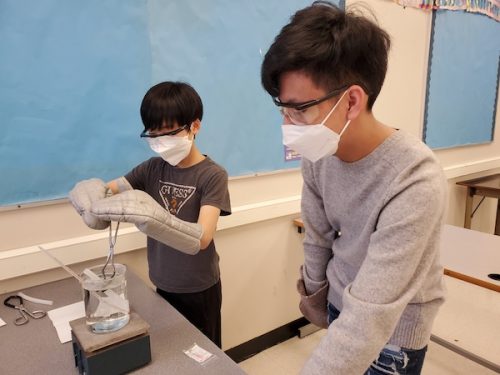
Students from Port Moody Secondary School testing procedures for the selected flight experiment, The Changes in Beneficial Metabolites by Lactic Acid Bacteria in Microgravity.
Proposal Summary:
Microorganisms have been found to react differently in microgravity conditions (8, 9). Bacteria composing the human gut microbiome provide many benefits (10) and affect the host both physiologically and psychologically. (11, 12, 13) Bacteria in the gut produce vitamins otherwise not synthesized in the body. These include B vitamins, vitamin C and vitamin K. (19, 20, 21, 22) B vitamins help the brain and energy production (27), and vitamin C is necessary for building and repair of tissues. (28) Most importantly, vitamin K is an important factor in bone mineralization. (24, 29) Furthermore, its metabolites, specifically butyrate, an SCFA have been linked to many health benefits from reduced inflammation to autophagy (14, 15), which will be beneficial for the reduction in frequent rashes or hypersensitivity, and loss of muscular mass commonly experienced in space. (16) Knowing if the production of these beneficial compounds changes can greatly affect the wellbeing of future astronauts in microgravity long-term. The investigation will look at the effect of microgravity in the production of short-chain fatty acids (SCFAs) by Lactobacillus casei (HA-108), Lactobacillus rhamnosus (HA-111), Lactobacillus acidophilus (HA-122), and Bifidobacterium longum (HA-135) in the fermentation of prebiotic fibers present in chia (Salvia hispanica) seeds.
HONORABLE MENTION FINALISTS:
Growing Bacillus subtilis Using Nutrient Agar in Microgravity
Grade 8, Hillcrest Middle School
Co-Principal Investigators: Marisa Bassetto, Selina Zhang
Teacher Facilitator: Patrik Ingelman
Proposal Summary:
With our experiment we want to find out if growing Bacillus subtilis in microgravity will be different from growing it on Earth. We will test that out by sending B. subtilis on an agar slant to the ISS. Bacteria is essential for decomposing plants and recycling nutrients along with countless studies that it has been used for. We chose B. subtilis because it is one of the most studied bacteria and it grows easily. By sending B. subtilis into space and seeing if it grows properly, we can learn whether it can be used to help plants or food grow in space. Another reason this experiment would be useful is because it helps us understand how this bacterium grows, and if we ever need to learn more about bacteria, we can see how they grew in nutrient agar. We hypothesize that the bacteria will grow into multiple colonies just like it would on earth, however, we think that it will do it slower than it would on earth and/or mutate because of the harsher conditions.
The Effects of Microgravity on the Growth Pattern and Germination of Buckwheat
Grade 10, Dr. Charles Best Secondary School
Principal Investigator: Jisong Han
Teacher Facilitator: Julia Hamilton
Proposal Summary:
As humanity continues to march towards the achievement of the goal of space colonization, more astronauts are going out in space to explore its environmental conditions. When astronauts are in space, they will surely be willing to bring plants with them for research, aesthetic reasons and as a possible source of food. Specifically, buckwheat (Fagopyrum esculentum) seeds would be one of the best plants to bring up to space due to their nutritional values that are suited to support the health of astronauts. According to Medical News Today (2019), buckwheat is high in minerals such as iron and magnesium and it has a considerably low amount of antinutrients. Also, it contains some vitamins such as vitamin K and vitamin B-6. Most importantly, because of the rutin and fiber that a buckwheat plant has, it can also prevent health problems related to microgravity such as high blood pressure (Johnson 2019). In this experiment, buckwheat seeds will be sent up to space and water will initiate their germination process. Then, their germination process will be stopped with a fixative solution. After, the seeds will be compared to the control group that was raised on Earth. This investigation will provide data about the germination of buckwheat in microgravity which could contribute to the acknowledgement of the potential merits that planting buckwheat offers to space exploration. Furthermore, the data gathered from this investigation will provide support for the current understanding of organization of cell division and tissue growth of a plant’s root.
3. Moreno Valley, California
Jump to Moreno Valley’s Community Profile
SELECTED FOR FLIGHT:
The Effects of Microgravity On The Germination Of Carrot Seeds
Grades 11 and 12, Valley View High School
Co-Principal Investigators: Andrea Cortez, Georgina Ramirez
Co-Investigators: Alexis Cuevas, Lindsey Luong
Collaborator: Jocelyn Mora
Teacher Facilitator: Salvador Martinez
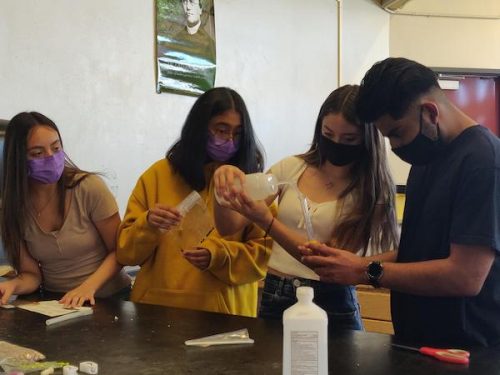
Moreno Valley’s researchers exploring the Effects of Microgravity on The Germination of Carrot Seeds. L to R: Georgina Ramirez, Jocelyn Mora, Andrea Cortez, and Alexis Cueva. Lindsey Luong (not pictured.
Proposal Summary:
The goal of the experiment is to compare and contrast the germination of carrot seeds in microgravity and on Earth experiments. One main reason for this study is to determine if carrots are a possible resource to consume. This experiment will determine if carrots can be an accessible resource for consumption in microgravity. The study will showcase how carrots can be a helpful resource to provide protein and other vitamins to help occupants on the ISS to maintain their health. If the experiment is unable to sustain a steady growth on the ISS, the carrots will not be brought to the ISS in the future. Further research will be conducted to find substances that can provide health benefits to help people on the ISS to survive if strawberries aren’t able to grow on the ISS.
HONORABLE MENTION FINALISTS:
Decomposition of Ants
Grade 11, Valley View High School
Principal Investigator: Daniel Plimley
Investigator: Ryan Vang
Collaborator: Alex Rivas
Teacher Facilitator: Stacy Katzenstein
Proposal Summary:
Decomposition in Space. Everyone thinks about how we can improve our technology to better keep our astronauts alive, but no one thinks about what happens when an astronaut dies in space. Specifically, how the process of decomposition acts differently on the corpse in a microgravity environment. Our experiment seeks to measure the effects of putrefaction, whether it be a subtle change or substantial change, on dead ants. There will be two sets of ants; one group on the ISS and the other on-orbit. We hope that we can provide a better understanding on the topic of decomposition in microgravity through our experiment.
The Effects of Microgravity On Arnica Plant Stem Structure
Grade 10, Canyon Springs High School
Co-Principal Investigators: Albert Joseph Erazo, Julietta Marleny Lopez
Co-Investigators: Izek Presley Diaz, Sandra Marlene Gomez, April Gutierrez
Teacher Facilitator: Divina Elbo
Proposal Summary:
In this experiment, Arnica Montana will be sent aboard the ISS in order to observe the effect of microgravity on plant stems. The structure of plant cells is similar to that of bone cells. In a plant cell there are cell walls that keep structural integrity much like the skeleton of a human body. Past space flights have shown that spending time in microgravity reduces the astronauts’ bone density resulting in it being difficult to walk after returning to Earth. The goal of this experiment is to see if the same occurrence will happen to plant stems while they are in microgravity. Once it comes back down to Earth, the investigatory team will compare the structure’s integrity of the Arnica plant grown in microgravity and on the ground. This will be done by weighted clamps on the stem until they break. The choice of Arnica is based on the use and needs of the plant. The flower is useful in medicine which means it could be taken on space expeditions. However the flower requires a strong stem for sunlight access. If microgravity has a negative effect on the tensile strength then there is no purpose of using it or any stem relying plant.
4. Perris, California
Jump to Perris’s Community Profile
SELECTED FOR FLIGHT:
The Effect of Microgravity on the Germination of Quinoa
Grade 6, March Mavericks Middle School
Principal Investigator: Kiedan Sareth
Co-Investigators: Enrique Rodrigues Ruiz, Jonathan Zamora
Teacher Facilitator: Lisa Petmecky
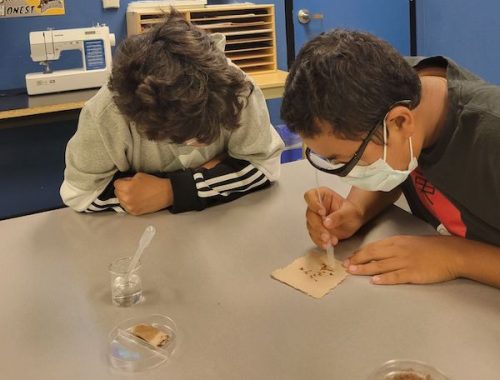
The students are investigating various seeds within the sample to inspect and determine which ones are germinating.
Proposal Summary:
After doing research, the students at March Middle School named Kiedan Sareth, Jonathan Zamora, and Enrique Rodriguez Ruiz are proposing the launch of an experiment on the germination and growth of quinoa. This test’s purpose is to see whether quinoa can germinate in space and how the effect of microgravity could change the quinoa seeds. If the experiment were to succeed, then the growth of quinoa seeds would be an improvement to the health of astronaut researchers and explorers. Quinoa is high in nutrients, fiber and amino acids, of which will enable the human body to continue growing and allow them to be less prone to diseases like diabetes. Quinoa, once grown, can be used as wheat or grain and may also be used in salads, with lush leaves and tender shoots, or stems. Growing quinoa would give astronauts more variety and keep them healthy as well if eaten raw.
HONORABLE MENTION FINALISTS:
Will Ginger Root Survive in Microgravity?
Grade 5, Columbia Elementary School
Co-Principal Investigators: Xiomara Jimenez, Raymundo Nevarez, Edwin Perez
Collaborators: Lennette Farias, Erick Garcia
Teacher Facilitator: Linda Brandt
Proposal Summary:
The investigation of the project will be the effects of ginger if ginger could grow in microgravity. The overall view of the project is to compare the difference between seed growth germination on the earth and microgravity. This mission will be conducted to show that ginger can be grown in space and heal nausea and potentially consume-in space. The principal objective of the experiment is to successfully show that ginger could grow in space. The team behind this investigation decided to choose ginger because it could heal nausea and it will be important for people’s health and other space flight personnel. The experiment contains putting ginger in the tube and water on the other side. at a congruent time, the ginger will be germinating on the earth out of microgravity. At a congruent time, the ginger will begin to grow. If they aren’t the same, it will conclude that microgravity affects ginger from growing.
The Effects of Microgravity on the Growth and Survival of Algae
Grade 11, Citrus School High School
Co-Principal Investigators: Lesly Castro, Yahaira Guevara, Keyonni Thomas
Teacher Facilitator: Julie Geary
Proposal Summary:
As our scientists continue with developing advances in space travel and working on ways to travel and inhabit Mars, many resources are needed for the success of the travels. Many astronauts spend a prolonged period of time in space which means they have a limited diversity of nutritious foods that they are able to consume. Many of the meals they eat have to be adapted to be safe under microgravity. Chlorella algae can be safely consumed by humans and serve as a great source of vitamin C, a wide range of antioxidants, and omega-3 fatty acids, which could be nutrients that are not common in space food. The investigation will focus on observing the growth and survival of chlorella algae in microgravity in order to know if algae can be a nutritious option that will help with the health of astronauts in space. Not only will having the knowledge of the survival and growth of algae in microgravity help determine an alternative nutritious food for the health of the astronauts, but it can also help with the possibilities of creating life on Mars. On Earth, algae releases oxygen and helps oxygenate the water and it also produces organic compounds. This experiment will also measure if the chlorella algae can grow or survive under microgravity in order for it to be safely placed on Mars in the future. This is in hopes that scientists can turn the barren planet into an earth-like green one in the future.
5. Redlands, California
Jump to Redlands’s Community Profile
SELECTED FOR FLIGHT:
The Effect of Microgravity on Weevils (Sitophilus Oryzae) Found in Rice
Grades 9 and 10, Redlands High School
Principal Investigator: Bernice Nunez
Co-Investigators: Diego Martinez, Francisco Perez Ortiz
Collaborators: Mathhew Daguerressar, Francesca Krstenansky
Teacher Facilitator: 1st Sgt. SMSgt. Ionne` Barnes-Joshua
Proposal Summary:
The experiment will be able to identify how weevil growth on rice is different from free fall to gravity, the investigation will help identify how in the future, foods can be transported and stored in space. Also, if the weevils are also able to grow in space, we could use these weevils to help pollinate other plants and help with the growth of plants.
HONORABLE MENTION FINALISTS:
Effect of Microgravity on the Effectiveness of Copper Sulfate as a Root Killer
Grades 11 and 12, Redlands High School
Co-Principal Investigators: Samuel Berkebile, Rowan Green, Kailana Nishiura, Kathryn Thompson, Shams Alsammarraie
Teacher Facilitator: Paul N. DeVoe
Proposal Summary:
In this experiment we studied the results of crystallizing copper sulfate under the effects of microgravity, then compared its effectiveness to otherwise identical crystals grown under normal conditions on the earth’s surface. Copper sulfate was chosen due to its usefulness in a variety of tasks, such as being a root killer and a fungicide, alongside its ability to be easily produced without the need for large external factors (such as temperature changes or sunlight). The space-grown crystals may prove to have advanced effectiveness, making them increasingly useful as farming supplements and for future space food growing.
How Effective are Bacteriophages in Killing Bacteria in Free Fall?
Grades 9 and 11, Redlands High School
Principal Investigator: Sharre Sinde
Investigator: Gabriel Grcich
Collaborators: Angeline Asatourian, Christeyonna Johnson
Teacher Facilitator: Julio Sandoval
Proposal Summary:
This experiment will focus on primarily bacteriophages. Bacteriophages are a type of virus that consumes bacteria. Although there has not been much research conducted on bacteriophages, this experiment aims to find if bacteriophages can detect and find bacteria in zero gravity, as well as consume and grow in population in free fall. This experiment will not harm the astronauts, as this experiment will not contain any dangerous products such as a live culture of bacteria and harmful bacteriophages.
6. Hillsborough County, Florida
Jump to Hillsborough County’s Community Profile
SELECTED FOR FLIGHT:
The Effects of Microgravity on the Bio-electrolysis of Anabaena sp. PCC 7120
Grade 8, Walker Middle Magnet School
Co-Principal Investigators: Brad Beenhakker, Henry Bravo, Rehan Dost, Samuel Fernandez, Rohan Halarnkar, Luke Oldenburg
Teacher Facilitator: Jodie Dukes
Proposal Summary:
The experiment the group is proposing will address the question “How does microgravity affect the bio-electrolysis of Anabaena sp. PCC 7120?” For humanity to explore the vast expanse of space it needs an easily obtainable fuel source to perform its exploration. The best fuel source for upper stages of spacecraft (the upper sections of the ship) and for deep-space travel is hydrogen because of its efficiency, energy density, and power. The most efficient way to produce hydrogen is through electrolysis, which splits water molecules into hydrogen and oxygen using an electrical reaction. Of the different forms of electrolysis, the proposed form is known as bio-electrolysis, which uses living organisms to naturally perform an electrolysis reaction. The reason the group is studying the hydrogen and oxygen production of the cyanobacteria Anabaena sp. PCC 7120 is to determine if it produces enough hydrogen and oxygen in microgravity to be useful in space travel. Anabaena sp. PCC 7120 is the species of choice because it produces excessive amounts of hydrogen and oxygen, both of which can be used for space travel. Although investigations have been performed in the ISS regarding photosynthesis, nothing has ever been performed to study the results of bio-electrolysis in microgravity. If bio-electrolysis in microgravity is shown to produce a significant amount of hydrogen and oxygen, then Anabaena sp. PCC 7120 may be a viable hydrogen fuel source to power humanity’s interstellar exploration.
Purslane Spaceflight Proposal
Grades 6 and 7, Randall Middle School
Co-Principal Investigators: Ayden Bartlett, Miguel Garcia, Aditya Laveti, Benicio Schuster
Teacher Facilitator: Mary Vaughn
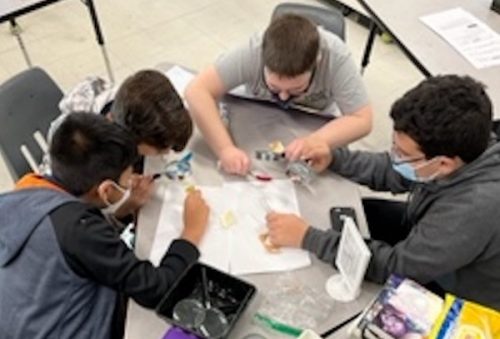
Randall Middle students collecting & recording data to optimize their microgravity experiment exploring germination & growth of Red Gruner Purslane for Microgreens (Portulaca oleracea) seeds.
Proposal Summary:
For this proposal, the investigation will explore the effects of microgravity on the Purslane plant (Portulaca Oleracea) and if Purslane is capable of properly growing and retaining nutrients in microgravity. The basis for this investigation is the prior knowledge that Purslane contains many nutrients including valuable Omega-3 fatty acids and high amounts of Vitamin E and beta carotene. If the hypothesis proves true, then Purslane will prove as an easy to grow, yet nutrient rich microgreen, even in microgravity. It may also provide a viable crop for long duration missions and stays at the ISS, as a way to have fresh food beyond our home.
HONORABLE MENTION FINALISTS:
Fenugreek and its Nutritional Value in Microgravity
Grade 6, Randall Middle School
Co-Principal Investigators: Sanjana Rao, Aadrita Roy
Teacher Facilitator: Mary Vaughn
Proposal Summary:
The Fenugreek team is testing Fenugreek growth in microgravity. The question is “Does microgravity slow the growth of Fenugreek affecting it’s nutritional value?” Analyzing this herb is crucial, to answer the essential question, and to create a reliable food source for astronauts. Another reason Fenugreek can help astronauts is it’s a rich source of calcium. Calcium is a substance known to increase bone mass, which is vital to astronauts as they can lose up to 20% bone mass in microgravity. As a result, calcium is a much-needed nutrient for astronauts. Fenugreek not only has calcium, but also many other nutrients. To address the question posed, the nutritional values of Fenugreek on microgravity and on Earth must be compared. A Brix Refractometer measures the nutritional value of any variety of solids, like Fenugreek. The role of the Brix Refractometer in the analysis will be to measure the nutritional value of the samples of Fenugreek from Earth and Space. Our team will use the Brix Refractometer upon Fenugreek’s return to Earth. As we complete post-flight analysis, we will measure the nutritional value of the sample from the ISS compared to the nutritional value of Fenugreek. Our team will grow in the classroom. The team will then be able to compare the results and finally answer the essential question. Our faction knows Fenugreek can be grown in the span of 30 days, since the germination rate is 2-5 days. Due to these factors, it would be beneficial to test Fenugreek growth in microgravity.
When Peas Fly (Testing the Germination Rate of Pisum Sativum Against the Effects of Microgravity)
Grades 6 and 8, Randall Middle School
Principal Investigator: Francesca Best
Co-Investigators: Gabriel Figueroa, Rylan Grayson
Teacher Facilitator: Mary Vaughn
Proposal Summary:
This investigation will provide information on how Sugar Snap Peas are affected by microgravity. The team chose Pisum Sativum as a viable crop for the experiment of growing stable, healthy crops. Sugar Snap Peas provide numerous nutrients including vitamins, fibers, proteins, and omega 3 fats. This makes the crop a healthy alternative to pre-packaged foods. These peas are also versatile, meaning they adapt easily to their environment. Growing peas using hydroponics is always an option, which reduces weight in shipping, as hydroponic systems do not use numerous materials. Overall, this experiment will provide beneficial information regarding the effect of microgravity on Pisum Sativum.
7. Ocala, Florida
Jump to Ocala’s Community Profile
SELECTED FOR FLIGHT:
What is the Effect of Microgravity on the Amount of Ethanol Produced by Yeast Fermentation?
Grade 5, Dr. N. H. Jones Elementary
Co-Principal Investigators: Anakan Keithan Gopalan, Aarya Jaiden Seevaratnam
Teacher Facilitator: Lisa Dorsey
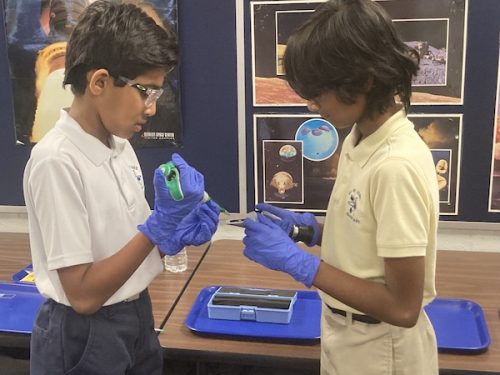
Flight researchers, Aarya Seevaratnam and Anakan Gopalan, from Dr. NH Jones Elementary School in Ocala, Florida preform preflight experiments.
Proposal Summary:
This investigation will determine the amount of ethanol produced by fermentation under microgravity in a period of time. In this experiment, glucose will be fermented using yeast to figure out the amount of ethanol produced under microgravity and will be compared to the amount of ethanol produced on Earth using the exact amount of glucose/yeast/water. Fermentation is a chemical process of converting carbohydrates or sugars into either ethanol or lactic acid without oxygen using microorganisms. The type of organism used in fermentation determines the by-products. With yeast fermentation, ethanol and carbon dioxide are produced. The amount of ethanol produced in weightless condition within a period of time depends on how yeast feeds off glucose for energy. Research shows that saccharomyces cerevisiae, yeast, is very virulent in microgravity meaning fermentation could be faster, therefore, ethanol can be produced faster. Fermentation plays an important role in food and alcoholic beverage production, food preservation, the production of biofuel, nutritional supplements, vaccines, and waste management. Fermentation makes food richer in nutrients by breaking down the nutrients and making them easier to digest. Fermented food increases the amounts of good bacteria in the digestive system, which boosts digestion, immunity, and antioxidants. These health benefits can have a positive impact on the health of astronauts. The outcome of this experiment is important since fermentation can be used to recycle waste in space and the by-products can be used for other purposes such as biofuel, disinfectants, and photosynthesis.
HONORABLE MENTION FINALISTS:
Can Isopropyl Alcohol Kill Escherichia Coli in Microgravity?
Grade 5, Dr. N. H. Jones Elementary
Principal Investigator: Journee Hammond
Co-Investigators: Saiyara Chetty, Collins Sheldon
Collaborator: Savanna Eatman
Teacher Facilitator: Lisa Dorsey
Proposal Summary:
This experiment will determine if isopropyl alcohol can kill Escherichia coli (E. coli) in microgravity as it does on Earth. E. coli has been found on all continents of Earth and all biomes of the world; furthermore, E. coli has been detected at the International Space Station (ISS). On Earth, under normal gravitational conditions, a solution of isopropyl alcohol with 70% alcohol has proven to effectively and quickly kill Escherichia coli. Advancements in manipulating and eliminating E. coli in microgravity through the use of isopropyl alcohol can lead to breakthroughs in controlling other bacteria, even those not yet discovered. Due to the recent findings of previously undiscovered bacteria living on the International Space Station, scientists will need a better understanding of how to keep bacteria under control. The health and safety of future generations could depend on the outcome of this, and related experiments performed in microgravity. As humankind eyes the possibility of colonization of distant planets, humans will inevitably come in contact with new, potentially dangerous bacteria. This experiment seeks to confirm if isopropyl alcohol is equally effective in microgravity environments as it is on Earth, and possibly to provide breakthroughs in bacteria elimination in those environments.
Sunflowers in Space
Grade 6, Horizon Academy at Marion Oaks
Co-Principal Investigators: Not available at this time
Teacher Facilitator: Joseph Alogna
Proposal Summary:
Seeds in space must be able to stand up to large doses of ultraviolet and cosmic radiation, low pressure, and microgravity. Seeds on the international space station sprouted roots that behaved like they would on Earth, growing away from the seed to seek nutrients and water in the same pattern observed with gravity. But Sunflower seeds need good sunlight to grow and to grow better and stronger. Sunflower seeds need sun and water to grow just like other flowers. So, will the sunflower grow in space? Or how can it grow in space? Another special reason to have sunflowers is because they grow sunflower seeds and we need to see if they can grow sunflower seeds even though they are in a small tube and see how it adapts to its environment, will they not grow? will it look weird; would it be funny looking? I want to send seeds into space because it would be interesting to see how all the different effects that space has and how they disturb or enhance the plants’ growth. The plant will not grow I the first place. The plant we want to send is a smaller breed of sunflower, the Helianthus Annuus or Elf Sunflower. They will need to be able to survive very many harsh conditions. Water will be stored in separate containers to keep the flowers alive.
8. Lake Charles, Louisiana
Jump to Lake Charles’ Community Profile
SELECTED FOR FLIGHT:
Sunflower Microgravity Growth
Grades 6 and 7, F.K. White Middle School
Principal Investigator: Priscilla Moncada
Co-Investigators: Edith Evey, Cynthia Chulo
Teacher Facilitator: Dana Istre
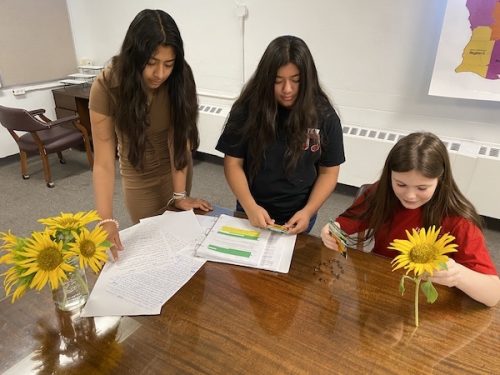
Cynthia Chulo, Priscilla Moncada, and Edith Evey, student researchers of selected flight experiment: Sunflower Microgravity Growth, reviewing and refining their proposal procedures.
Proposal Summary:
The investigation will attempt to determine whether or not the germination of sunflower seeds will be affected by exposure to a lack gravity. The Space Investigators will leave the sunflower seeds alone during the experiment on the International Space Station. When the seeds return to Earth, there will be an experiment conducted to determine whether or not the seed’s exposure to a non-gravitational environment has affected its ability to germinate on Earth.
HONORABLE MENTION FINALISTS:
Growth of Bacillus Coagulans in Microgravity
Grade 7, F.K. White Middle School
Principal Investigator: Sam Dondapati
Teacher Facilitator: Dana Istre
Proposal Summary:
This experiment will see what happens to the growth rate of Bacillus Coagulans in microgravity. My hypothesis is that the bacteria Bacillus Coagulans may have higher growth rates due to the lack of gravitational stress/mechanical stress. Bacillus Coagulans is a probiotic culture. Astronauts work a lot in the International Space Station, they require good amounts of energy, and it is necessary to boost their immunity. This bacteria could be eaten with an edible media as a supplement for astronauts for better digestion which in turn gives more energy and more nutrients due to the more efficient digestion process. This would also cause astronauts to not be as hungry and eat less, making it cheaper to buy and ship food to the International Space Station for astronauts. There will be a ground truth sample conducted at the same time as the space orbit sample to compare the growth rate of the space orbit sample to help us get our answer. These bacteria are not pathogenic. Growing the bacteria Bacillus Coagulans in space would not need many resources. Overall, the bacteria would be helpful in many ways.
How is Yeast Fermentation Affected by Microgravity
Grade 7, F.K. White Middle School
Co-Principal Investigators: Kevin Hazell, Ruth Rohrbeck
Co-Investigators: Nathan Funderburgh, Caroline Dyson
Teacher Facilitator: Dana Istre
Proposal Summary:
Does yeast expand and mix the same way it does with gravity than without gravity? The team is proposing an investigation that will aid our understanding of how yeast reacts in space without gravity. As well as an experiment on Earth to compare results in order to devise a rational conclusion on whether yeast fermentation is affected by zero gravity. The team will put yeast and water in the test tube provided then it will be mixed by the crew. The team chose that this experiment would be suitable for this program because it furthers our understanding of yeast fermentation in space. Our understanding of yeast fermentation in space is important because yeast fermentation or bread could be used in the future as a viable food source for various space frontiers. If yeast fermentation is confirmed as a conceivable process that can be performed in space, then it will change what kinds of sources of nutrition that can be considered as a feasible food that can be made in space (e.g., bread, kimchi, sauerkraut, kefir, tempeh, kombucha, and yogurt). These foods are potentially accommodating to the astronaut’s diet as they may reduce heart disease risk and aid digestion, immunity, and weight loss which would demonstrate its helpfulness.
9. University System of Maryland, Maryland
Jump to USM’s Community Profile
SELECTED FOR FLIGHT:
Generation of Metallic and Ceramic Nanoparticle Aggregates in Microgravity for Novel Insights into Planetary Formation
Grade 14, University of Maryland, College Park
Co-Principal Investigators: Vincent Lan, Adrian Seemangal
Investigator: Brian Sun
Teacher Facilitator: Michael Kio
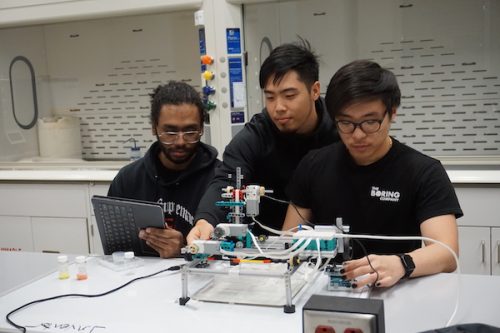
The Terps in Space Mission 16 team working together in the lab. Left to right: Adrian Seemangal, Vincent Lan, and Brian Sun.
Proposal Summary:
Nanomaterials are composed from as little as 10 atoms but have contributed to revolutionary advancements in many fields including energy, medicine, manufacturing, and computing. Not only are nanomaterials the foundation for many of humanity’s greatest modern achievements, but they may also serve as principal components to understanding the initial formation mechanisms of planetary bodies. Nanoparticles contain a relatively few numbers of atoms with many atoms residing on the surface, contributing to a great amount of surface energy compared to larger bulk materials. To reduce energy, nanoparticles cluster form aggregates. Current understanding of planet formation relies on the sticking and clustering of cosmic dust particles, aided by a star’s gravitational and magnetic field. Once diameters exceed a few centimeters, aggregates transition into planetesimals and self-gravitation becomes the primary growth mechanism. However, before that point in the millimeter-to-centimeter range, planetesimals bounce off one another instead of sticking together, hindering growth. This specific problem has puzzled planetary scientists. Thus, this investigation will seek insights from the formation of metallic and ceramic nanoparticles clusters in microgravity to develop detailed understanding of planet formation. Metallic and ceramic particles represent the compositions of the cosmic dust considered to be the building blocks of the Solar System. Understanding aggregation of nanoparticles will enhance the efficiency of novel technologies including, but not limited to, heat-based cancer treatment, 3D-printed electronics, and the operation of portable MRI devices on the International Space Station (ISS). Insights from this investigation could contribute to the advancement of these technologies.
HONORABLE MENTION FINALISTS:
Effects Of Microgravity On The Efficiency Of Trypsin
Grades 12, 13 and 14, University of Maryland, College Park
Co-Principal Investigators: Taylor deSilva, Ohzmar Evardo, Kaya Ozgun
Teacher Facilitators: Julia Zhang, Naila Al Hasan
Proposal Summary:
When subjected to low gravity, liquids behave very differently than they do in Earth’s gravity. And since the human body is filled with fluids, astronauts are also affected. In the case of the digestive system, we predict that the properties of microgravity will hinder its ability to initiate chemical reactions. Enzymes are substances that accelerate such chemical reactions by binding onto proteins. Enzymes are also very sensitive to the conditions of their environment, such as pH and temperature, and can break down if conditions are unfavorable. Enzymes play an important role in digestive processes and a deficiency can lead to metabolic disorders; lactose intolerance, for example, is caused by a deficiency in the enzyme lactase. This experiment will test the efficiency of an enzyme, known as Trypsin, to break down a solution of Azocasein in microgravity. Trypsin is an enzyme found in many animals, such as fish, insects, and mammals, and helps in decellularization, regulating digestion, and activating other proteins. The efficiency of Trypsin will be measured by Azocasein, which releases a dye when processed by enzymes. The results of this investigation will provide further research in our understanding of enzyme catalysis and help future astronauts prepare for metabolic issues in long-term missions in space.
Blood Storage For Deep Space Exploration
Grades 13 and 15, University of Maryland, College Park
Co-Principal Investigators: Saul J. Flores, Janam Shankar, Nikola Susic
Investigator: Elyas Masrour
Teacher Facilitator: Dr. Kenneth Frauwirth
Proposal Summary:
With novel advances in aerospace technology, deep space exploration is beginning to be possible. Still, expanding our horizons will require innovations in many fields, especially the medical field. Currently, in the event of an injury and severe blood loss, astronauts are instructed to transfuse blood from one individual to another. This protocol poses many complications with the quantity of blood and matching blood types. Also, there have been mixed findings on the effect of microgravity on blood clotting of blood in space. Hemostasis (i.e. blood clotting) is a complex enzymatic cascade involving factors such as thrombin and fibrin, and serves to stop blood loss. However, hemostasis can be problematic if it arises in stored blood as it could lead to complications in transfusion and conditions such as deep vein thrombosis. Thus, it is vital that the current storage methods of blood are evaluated in a microgravity environment to determine the risk of clot formation in stored blood. In this experiment, we aim to measure the formation of blood clots in stored blood by assessing the activity of the serine protease thrombin under microgravity conditions.
10. Grand Blanc, Michigan
Jump to Grand Blanc’s Community Profile
SELECTED FOR FLIGHT:
Microbial Solutions for Food Waste In Space
Grade 8, Perry Innovation Center
Co-Principal Investigators: Genevieve Monterosso, Isaiah Marble, Kenedy Brazell, Patrick Ireland, William Dean
Collaborators: Connor Burton, Zeyland Holden
Teacher Facilitator: Jason Valimont
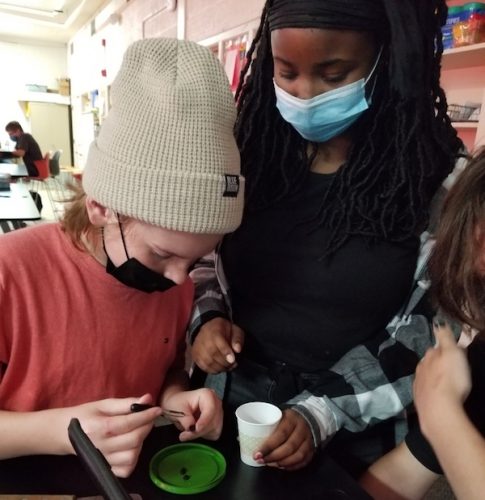
Students from Perry Innovation Center work with blueberries as they refine their experiment to be sent to the ISS.
Proposal Summary:
On Earth, food waste in America alone includes 1.3 billion tons of food every year and often sits in landfills. Finding solutions to efficiently decompose food matter that may be used again for growing new food in microgravity is key to sustainable space exploration. This is important because more people will be visiting space where they will have greater quantities of food waste in the near future. Our research question is: How is the decomposition of blueberries affected by microgravity? This experiment should be conducted in microgravity because the results could greatly benefit space agricultural programs. This investigation will analyze the decomposition of rehydrated blueberries on the ISS and here on Earth. Observations and measurements will be taken based on the weight, size, microbial film, and appearance of the blueberries.
HONORABLE MENTION FINALISTS:
How Do High Molecular Weight Polyethylene Glycol and Medium Molecular Weight Hydrochloric Acid Diffuse Together in Microgravity?
Grade 8, Perry Innovation Center
Co-Principal Investigators: Adam Bacon, Connor Burton
Co-Investigators: Noah Mitchell, Zeyland Holden
Collaborator: Rean Turner
Teacher Facilitator: Jason Vallimont
Proposal Summary:
The experiment that will be conducted is designed to test how, in a microgravity environment, a high molecular weight liquid would diffuse with a liquid of medium molecular weight. This will be tested by diffusing high molecular weight polyethylene glycol and hydrochloric acid in the FME. After the experiment, the acidity of the two newly formed solutions will be tested to indicate diffusion. If the experiment is a success, the new mixture/solution when fully diffused could be used to clean future spacecraft, space debris, and segments of the ISS. The information gathered from this process could also facilitate the creation of future experiments related to molecular weight, since there is a lack of scientific knowledge in this field of research. In short, the experiment at its core is designed to further increase the efficiency of cleaning solutions in space, and to open a new field of research to be explored in microgravity.
How does Lactose React to Stomach Acid in Microgravity?
Grade 5, Perry Innovation Center
Co-Principal Investigators: Jayden Harvey, Joseph Given, Lily Hamilton, Ty Folks, Vincent Angelini
Teacher Facilitator: Jaime Cramer
Proposal Summary:
The question that the experiment focuses on is how lactose reacts to stomach acid in microgravity. Did you know that the number one allergy on Earth is related to lactose (West, R. H. D. 2017, January 25)? When lactose goes undigested, it causes health issues like asthma and digestive disorders. The investigation will find out if microgravity affects the digestion of lactose. The investigation will use Nepali Chhurpi to send lactose into microgravity. This hard cheese does not require refrigeration. The experiment will test the digestion of this form of lactose by using acid that mimics stomach acid and a lactase supplement that mimics the enzymes released by the pancreas during digestion. We will compare our results by doing this experiment on Earth. Then send the same experiment to space, with the changed variable of microgravity. The results will determine how microgravity may affect lactose allergies and intolerances.
11. Hoboken, New Jersey
Jump to Hoboken’s Community Profile
SELECTED FOR FLIGHT:
The Effect of Microgravity on Catheter Biofilm Formation by the Bacterium Pseudomonas fluorescens
Grade 11, Hoboken High School
Co-Principal Investigators: Feline Dirkx, Kai Hultstrom
Teacher Facilitator: Jean Lebegue
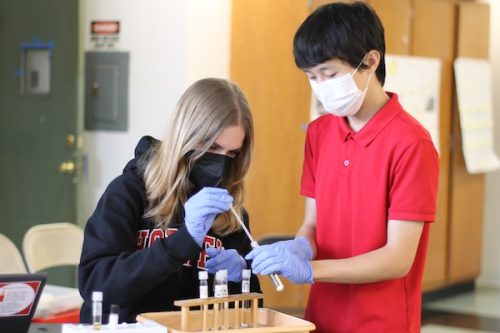
Feline Dirkx (L) and Kai Hultstrom (R) inoculate a test tube containing bacterial culture medium and silicone beads with the organism Pseudomonas fluorescens as part of their space flight testing experiments.
Proposal Summary:
We propose to answer the question: What will be the effect of microgravity on biofilm secretion by the bacterium Pseudomonas fluorescens? Pseudomonas fluorescens is a common, gram-negative, rod-shaped bacterium. When Pseudomonas fluorescens adheres to an object with a moist environment, it grows biofilm. The objective of this research project is to see the effect microgravity has on the formation of Pseudomonas fluorescens biofilm. A biofilm is a hydrophilic substance secreted by the bacteria, forming around microcolonies, acting as protection from the immune system and antibiotics, and as a physical layer of protection from other elements. To execute this experiment, we’ll use a FME device which is a 3 chamber experimental system, in which volume 3 holding 10% neutral buffered formalin, volume 2 holding tryptic soy broth with a catheter, and volume 1 holding powdered lyophilized culture of Pseudomonas fluorescens. All the used equipment will be completely sterilized before the experiment. The minilab will be kept in an ambient temperature as this bacterium is known to grow best within an ambient temperature range. Pseudomonas fluorescens will be allowed to grow at this temperature for 2 days as the preliminary optimization experiments determined Pseudomonas fluorescens reached its maximum growth after 48 hours. After 2 days, the investigation will end, using the 10% neutral buffered formalin. After the investigation has ended and the minilab system is delivered back to Earth, the catheter will be analyzed for biofilm secretion and growth and absorbance of the mixture will be measured using a spectrophotometer. This data would then be compared to the ground experiment completed on Earth beforehand determining whether the secretion increased.
HONORABLE MENTION FINALISTS:
The Effect of Microgravity on Oxygen Dependent Polyphenol Oxidase L-tyrosine Oxidation
Grade 12, Hoboken High School
Co-Principal Investigators: Jorge L. Carreon, Rowan Ellison
Teacher Facilitator: Jean Lebegue
Proposal Summary:
Enzymatic browning is a deleterious process that occurs in a variety of fruits and vegetables, such as apples, avocados, bananas, and potatoes.1-4 When looking to the future of human presence in space, it is important to consider whether food will preserve differently, as this would influence the extent to which food preservation technologies are utilized, and enzymatic browning is an important place to start. This experiment thus measures the extent of enzymatic browning through tracking melanin levels via spectrophotometer7,9 following a reaction between L-Tyrosine and oxygen, catalyzed by tyrosinase.5,6 This reaction is set up using the FME device, with one compartment (C1) filled with 6 mL of a 0.1 M phosphate buffer and roughly 1 mL of air and the other (C2) filled with 0.08 g of L-tyrosine and 1 cubic cm of ground dried apple. The experiment will be repeated twice concurrently, once on Earth and once aboard the ISS. Those running the experiment will be instructed to release the clamp separating C1 and C2 and maneuver the FME device so the ground apple and L-tyrosine may fully enter into the phosphate buffer. Next, they will be instructed to shake the device vigorously for roughly 5 seconds, to ensure the components are thoroughly mixed, so the reaction may proceed as fully as possible. No further interaction is required until the FME device is returned to Earth; afterward, a spectrophotometer will be employed to measure and compare the melanin absorbance resulting from each experiment.
The Effect of Microgravity on the Contractility and Atrophy of the Oryctolagus cuniculus Muscle.
Grade 10, Hoboken High School
Principal Investigator: Leah Katell
Teacher Facilitator: Jean Lebegue
Proposal Summary:
The main purpose of the study is to show how a microgravity environment will affect muscles by studying how well the muscle contracts and atrophies. Every astronaut has to worry about the toll that space takes on the body and especially on the muscles. Scientists know that this is a problem. In an eleven-day study, as much as 30 percent of muscle fibers were affected after acclimating back to Earth’s gravity (Smith, et al, 2019). This shows that astronauts lose their muscle mass, which can be dangerous in space and when back on Earth. A microgravity environment is needed to test this because scientists already know how muscles work in a non-gravity environment. Knowing this information could be the key to space colonization and longer missions on either the ISS or Mars. In the study, muscle fibers will be cut and teased and put in a solution of potassium chloride, magnesium chloride, and adenosine triphosphate (ATP) as this was found to be the optimal solution to allow maximum muscle contraction. All of the muscles will be measured and recorded the initial and final lengths to test muscle capability. As a method of testing atrophy, the width of the muscle fibers will be measured before and after going into space using a microscope. The same experiment will be run on Earth in order to test the effect of microgravity on muscle fibers.
12. Albany, New York
Jump to Albany’s Community Profile
SELECTED FOR FLIGHT:
Microgravity’s Effect on the Germination of Basil Seeds Using Hydroponics
Grade 8, William S. Hackett Middle School
Co-Principal Investigators: Aimee Diana Arias, Alina Gasanova, Kaylee Garcia Ramirez, Jasmine Suarez, Sage Volmer
Teacher Facilitator: Craig Ascher
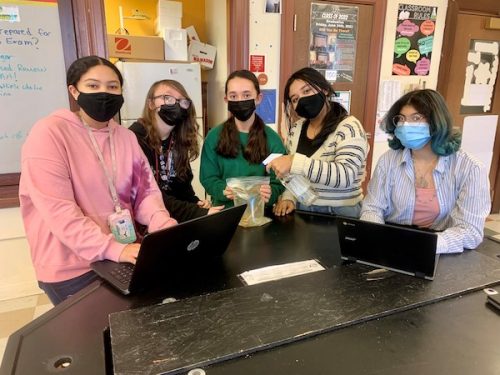
Students from Albany, NY, conducting a trial experiment to investigate the effectiveness of vinegar as a fixative for basil plants in advance of their space flight experiment.
Proposal Summary:
Our group wants to see how basil seeds (Ocimum basilicum) when in space (exposed to microgravity) will be affected. The experiment will be using hydroponics to help the seeds germinate. Hydroponics, according to the Hydroponics 101 handbook, is “a method of growing plants in a soil-free, nutrient-rich water solution.” The same experiment will be conducted on Earth to serve as a control group. This will be done using a duplicate of the Type 3 FME Mini-Lab sent to the ISS. The only difference is that the basil seeds on Earth will be exposed to sunlight and gravity. When the experiment ends, the seeds in the mini-lab from the ISS will be compared with the seeds in the mini-lab that were on Earth. The comparison will be done to see any differences in germination. The data will be measured by using a microscope and metric ruler. Therefore, it will be accurate and visually represented by a data table. This experiment was chosen because of its health benefits that could assist and or aid astronauts on the ISS. In addition, more information will be collected on agriculture in space, a major part in the possible creation of colonies on different planets in the future.
HONORABLE MENTION FINALISTS:
Effect of Microgravity Affect the Speed of Germination in Arabidopsis thaliana
Grade 8, William S. Hackett Middle School
Co-Principal Investigators: Andrew Gish, Andrew Jacinto, Tristan Peterson, Ian Roach
Teacher Facilitator: Craig Ascher
Proposal Summary:
The goal for this experiment is to find out the effects that microgravity has on the germination for the Arabidopsis plant. This experiment is beneficial because it is a way to improve the world’s production of agricultural based food. This experiment will allow for an insight on what scientists should do to help fix world hunger. Based on the results of the experiment, scientists will be able to figure out whether or not to invest in planting food in space. Whether the seed germination slowed down or sped up will help save time in resources while producing more agricultural based foods. This experiment could also reveal the relationship between gravity and the process of an arabidopsis dehydrating itself. The Arabidopsis thaliana does this to maintain homeostasis. Keeping with the same topic, in some previous experiments investigating the effects of microgravity on seed germination, microgravity had many different subtle effects on the seed germination process. These included seed size and the direction of root growth, among other things. This experiment could help get a better understanding of what causes these effects, and how to possibly prevent them.
Microgravity’s Effect on Fungi Cell Structure Growth and Behavior
Grade 8, William S. Hackett Middle School
Co-Principal Investigators: Kelise Cambell, Reign Hannah, William Htoo, Quahdre Murdaugh, Anyia Mott
Teacher Facilitator: Craig Ascher
Proposal Summary:
The goal of the experiment is to see how microgravity meddles with the fungi Aspergillus. To go into detail, the investigation will be looking into how it affects its growth/development in cell structure and its adaptations in microgravity. It is important because in microgravity fungi might grow differently. For example in microgravity the fungi cell structure may grow differently and/or faster, this could help because people may be able to grow more food in microgravity and the food may grow fast, with the fungi growth the world could see if its true and how microgravity will affect food growth so that way the world won’t have to worry about world hunger. Not only this but the adaptations are also important because it could affect how the fungi acts in space which could then lead to differences in population.
13. Buffalo/Niagara, New York
Jump to Buffalo/Niagara’s Community Profile
SELECTED FOR FLIGHT:
The Effect of Microgravity on the Resistance of Staphylococcus epidermidis to Oxacillin
Grade 10, Wellsville Secondary School
Co-Principal Investigators: Serena Boussa, Elijah Brophy
Co-Investigators: Aidan Jadwin, Ben Jordan
Teacher Facilitator: Ross Munson
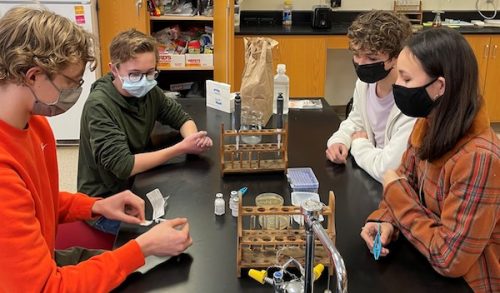
The flight team is opening a syringe in order to soak filter papers with Oxacillin antibiotic to test antibiotic resistance of S. epidermidis.
Proposal Summary:
This experiment strives to test the effect of microgravity on the susceptibility of Staphylococcus epidermidis to oxacillin. Multiple studies carried out through NASA and other organizations have observed that increased resistance to antibiotics as a common trait expressed by bacteria that have been exposed to space travel. The cause of this change remains unclear. In an attempt to gain further information on this topic, studies have been carried out by many; however, these tests yield inconsistent data. Through this program our experiment will provide direct and invaluable information to address increased bacteria resistance by exposure to microgravity. After analyzing our results, we will be able to verify if susceptibility is altered. By comparing this to other tests we can determine how resistance varies based on bacteria species. The outcome will add to the current understanding. Based on our team’s research it is hypothesized that Staphylococcal epidermidis will become more resistant to the oxacillin, an antibiotic to which it was previously susceptible. The results of this experiment are extremely valuable when considering the future of space travel. The safety and ability to perform by astronauts is heavily affected by this topic. Gaining a solid understanding of this will allow us to embark on missions with longer duration, maintain astronaut health, and achieve goals such as commercial spaceflight. It will also allow us to make further advancement in our understanding of modern medicine, a variety of bacteria types, and the microgravity environment.
HONORABLE MENTION FINALISTS:
Microgravity’s Effect on The Rate of Consumption in Halomonas titanicae vs. Normalized Gravity
Grades 9, 10 and 11, Lockport High School
Co-Principal Investigators: Joshua Frank, Zachary Sanders
Co-Investigators: Anthony Bernardi, Jason Czechowicz
Collaborator: Cody Mathews
Teacher Facilitator: Shelley Bochicchio, T. Schultz
Proposal Summary:
Halomonas titanicae is a recent discovery in microbiology. Halomonas titanicae is a heterotrophic, aerobic, non-pathogenic, bacterial strain, first discovered in the shipwreck of the RMS Titanic. This bacteria is uniquely halotolerant, meaning it functions best in environments of varying concentrations of salt. It is also especially unique because of its ability to feed on rusticles, icicle-like formations of rust, in areas of the deep-water like the Titanic. Because of how new this bacteria is to the scientific community, much is yet to be known about its consumption of rust. Examining the bacteria in the presence of microgravity will give more insight into the potential waste management uses for the bacteria. This experiment whether or not gravity affects the rate at which these bacteria consume rust. The team hypothesized that if a sample of freeze-dried Halomonas titanicae is activated in an environment where gravity has decreased effect, then it’s rate of consumption will increase because the bacteria will be able to move more freely and therefore have more interactions with the rust than if they were exposed to normal gravity.
The Effects of Microgravity on the Growth of Food Spoiling Bacteria, Lactobacillus Sp., on a Rehydrated Food Source
Grade 12, Wellsville Secondary School
Co-Principal Investigators: Cheyene Dickerson, Jaelyn Knapp
Co-Investigators: Mia Moradi, Luke Zakel
Collaborator: Evan McDowell
Teacher Facilitator: Ross Munson
Proposal Summary:
Food spoilage in microgravity is a pertinent issue given that long distance space travel will likely begin in the near future. With that in mind, finding the ideal way to preserve food for extended time periods in space is necessary. This experiment will test the effectiveness of rehydration as a preservation method against Lactobacillus sp., a common food spoiling bacteria, in microgravity. This will be done through the Student Spaceflight Experiments Program by sending the experiment in its Fluids Mixing Enclosure to space. Once on the International Space Station, a sample of dehydrated nutrient broth will be exposed to Lactobacillus sp. and a saline solution, which will rehydrate the nutrient broth. The bacteria will interact from the day of arrival until returning. An identical experiment will be carried out on the ground by the student team to act as a control. Once the space sample is returned, both the space and ground experiments will be analyzed to compare the bacterial growth and determine whether or not microgravity had a significant effect on the bacteria.
14. Garden City, New York
Jump to Garden City’s Community Profile
SELECTED FOR FLIGHT:
How does Microgravity Affect the Germination of a Tomato Seed?
Grade 7, Garden City Middle School
Co-Principal Investigators: Bridget Coviello, Isabelle DeNoto, Samantha Racich, Elsie Ross
Teacher Facilitator: Christine Lebenns
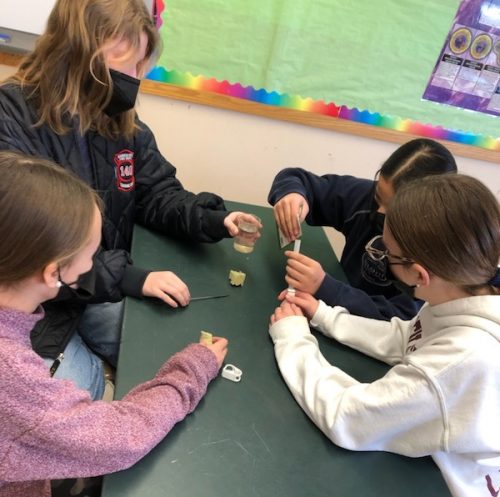
All girl research team from Garden City working on their experiment on germination of tomato seeds in microgravity.
Proposal Summary:
The experiment will allow to observe the differences between germinating seeds in microgravity as opposed to on Earth. Specifically, the germination rate of 3 cherry tomato seeds in space will be performed and studied to compare to germination on Earth. Cherry tomato, or scientifically known as Solanum lycopersicum var. cerasiforme seeds were chosen to investigate if agriculture could arise in space for long distance space exploration. If nutritious foods like tomatoes and other vegetables are able to grow in microgravity, then astronauts will be able to have a bigger variety of food sources. Tomatoes supply a large amount of antioxidants, which can help reduce the risk of heart disease and cancer in future space exploration. The healthy characteristics of cherry tomatoes are perfect for eating, making them helpful for a balanced diet. The cherry tomato seeds were also one of the tiniest compared to other seeds to use, so they were perfect for fitting inside the FME mini lab tube. This experiment is important because agricultural growth might come into play for future space flights, and would allow people in space to grow foods.
HONORABLE MENTION FINALISTS:
How will Microgravity Affect Germination of Broccoli Brassica Oleracea var. italica seed?
Grade 7, Garden City Middle School
Co-Principal Investigators: Riley Hansman, Eric Morales, Ashley Ryker
Teacher Facilitator: Christine Lebenns
Proposal Summary:
The investigation will study the effects of microgravity on the germination of the Brassica Oleracea var. italica seed (otherwise known as broccoli seed). We chose broccoli because it is a nutritional vegetable that can provide source of food and vitamins for astronauts if grown on orbit. Also, the seed of this plant is small and can fit easily into the FME mini lab. Brassica Oleracea var. italica require rich soil which we can put in with the seeds before sending them up into space to germinate in microgravity. The identical seeds in identical FME mini lab will be germinating under the effects of Earth gravity in our classroom. We will observe the differences and similarities of the appearance of the seeds germinated in space and on Earth.
Effects of Microgravity on the Hardening and Strength of Concrete
Grade 7, Garden City Middle School
Co-Principal Investigators: Aidan Eddleson, Merrick Fang, Colleen Irwin
Teacher Facilitator: Amanda Petersen
Proposal Summary:
The following experiment will investigate if dry concrete mix and water combined together will form concrete in space and how microgravity will affect its strength. Knowing if concrete can harden in orbit is important for space exploration. The type of concrete mix we are using is Quikrete Concrete Mix which is a blend of cement, sand, and gravel, which when mixed with water and dried, turns into a solid. The main purpose of this project is to understand how the mix of these materials interact with one another both on Earth and in space. On Earth, concrete is necessary for building infrastructures and the foundations of different structures. In space on other planets, concrete also can create the foundation of infrastructures and shelter. The knowledge of concrete formation in microgravity will help people to progress in future interplanetary exploration.
15. Norwood, New York
Jump to Norwood’s Community Profile
SELECTED FOR FLIGHT:
The Effects of Microgravity on Chlamydomonas reinhardtii Algae when Exposed to Optimal Nutrient Levels
Grades 8 and 10, Harrisville Central School
Co-Principal Investigators: Elaine LaVancha, Ethan LaVancha, Hailey Meagher
Teacher Facilitator: Nicole Taylor
Proposal Summary:
This experiment aims to analyze the effect of nutrients on algae growth in microgravity. Nitrogen and phosphorus are the two main nutrients being analyzed, as these are the chemicals that most affect algae growth. We will use a Fluids Mixing Enclosure (FME) mini-lab with three different sections, this will allow the algae growth to be activated and stalled in space. The algae being used is Chlamydomonas reinhardtii, a common pond algae. The study will examine the algae’s growth in biomass after flight to determine if the nutrient concentration was more or less effective in microgravity. The same experiment will be conducted on Earth under the same condition to see if it differs from the one that was in space. Algae is very important because it produces oxygen, can be used as fuel, a fertilizer, and can even be used as a food source. It cannot be understated the effect that algae have on ecosystems, as it provides about half the oxygen produced by photosynthesis in our atmosphere. This makes algae a very valuable resource for future missions in space exploration, and an invaluable resource here on Earth; which is why we chose to focus on algae in our experiment. It is our hope that the results of this experiment will help further our understanding of algae production here on Earth and in microgravity.
HONORABLE MENTION FINALISTS:
How does the Chemical Composition of a Cortland Apple Play a Role in Decomposition?
Grade 11, Harrisville Central School
Co-Principal Investigators: Alex Horten, Lila LaParr, Joanie Shaw, Evelyn Winters
Teacher Facilitator: Nicole Taylor
Proposal Summary:
This project is centered around the decomposition of fruit. The question being asked is, does the environmental factor affect the decay. The objective of the experiment is to compare the results in a microgravity environment to that of the gravitational force on earth. With landfills on Earth filling up fast, civilization is running out of room. If fruit decays faster in space, then food waste can be sent into space instead of landfills. The subject of the experiment is that a piece of fully ripened Cortland apple will be sent up in a refrigerated area to postpone the decaying process until it is in the proper environment. We will know that the apple is fully ripe if the stem can be pulled off easily. Once on the International Space Station, the test tube containing the apple will no longer be in refrigerated conditions to begin the experiment. Before departure from the station, a clamp will be removed to release the deactivator which consists of water, lemon juice, and salt. This will prevent the fruit from decaying any further. After returning to earth, the experiment will be compared to the control where the contrast will be observed. A similar experiment has been tested on the ripening of Mature green Cavendish Bananas (Dwivany, 2016).
Does Microgravity Have Any Effect on the Corrosion of Metals?
Grades 9 and 11, Harrisville Central School
Co-Principal Investigators: Nadia Atkinson, Maia Bernhard, Aaron Parow
Teacher Facilitator: Nicole Taylor
Proposal Summary:
The purpose of this experiment is to test whether microgravity has any effect on the corrosion of copper. The researchers believe that doing this experiment is important, as it could lead to a decision on whether or not copper is safe and efficient to use long term. For this experiment, there will be copper and water mixed prior to being sent up. To measure whether the change from gravity to microgravity affects the corrosion of the metal, and one of the two amounts that separate the metal and the water, to be combined on the ISS. Following the return of the mini-lab to Earth, the researchers will compare the weight and volume of the copper post-space with the control subjects and the subject that had nothing done to it at all. Using the data, the corrosion rate of these metals over longer periods of time could be calculated. The hypothesis of this experiment is that copper will corrode less while in space versus when it is not in space. The particular reason for this hypothesis is that the temperature and the level of oxygen are controlled on the ISS, and that the microgravity will cause the copper to be making contact with the water much less. The researchers will be using as close to the same exact conditions for both the control and the microgravity experiment.
16. Pickerington, Ohio
Jump to Pickerington’s Community Profile
SELECTED FOR FLIGHT:
Algae: The Fuel Source of Space
Grade 12, Pickerington High School Central
Co-Principal Investigators: Trevor Blankenship, Isaac Hoshor
Teacher Facilitator: Brian Hoff
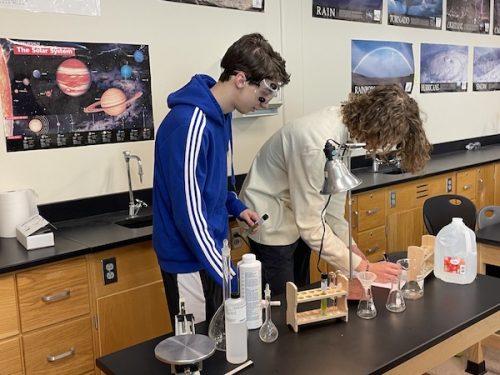
Student researchers Trevor Blankenship and Isaac Hoshor, from Pickerington High School Central, working on their experiment: Algae: The Fuel Source of Space.
Proposal Summary:
The experimenters will study the growth of Chlorella vulgaris and its capacity to produce oil for biofuel in microgravity, then compare it to the same experiment on Earth. As space travel becomes more prevalent in modern times, there will be a point where resources are limited on manned space expeditions. Missions will take much longer and require resources independent of Earth, the farther mankind attempts to travel through space. One necessary resource for expansion of humans into space is a source of fuel. Current fuel sources cause a greenhouse effect, which is one of the reasons we are looking for other bodies to inhabit in space. The algae Chlorella vulgaris can be used as fuel by growing it in space. Growing Chlorella vulgaris in space can fuel civilization on other planets.
HONORABLE MENTION FINALISTS:
Effects of Microgravity on the Pupation and Metamorphosis of the Leafcutter Bee Megachile rotundata
Grades 11 and 12, Pickerington High School North
Co-Principal Investigators: Arcadia C. Bach, Richard L. Heimerl
Teacher Facilitator: Adam Philpott
Proposal Summary:
The purpose of this mission would be to further the research that has previously been conducted to study the development of bees in space. This research aims to send the pre-pupae of the leafcutter bee Megachile rotundata to the International Space Station and compare how they undergo pupation and metamorphosis in microgravity. The same experiment will be conducted on Earth and the life cycles of the leafcutter bee will be compared. This experiment’s information on how bees develop in space could lead to advancements in the future of pollination and food growth in space. Using bees and other pollinators, the dream of colonies on other planets and humanity’s future in space can become all the more realistic. The key to such a future is food growth in space, and the key to growing food sustainably and efficiently at a large scale is pollinators, the best of which being bees.
Effects of Microgravity on the Pupation and Metamorphosis of the Leafcutter Bee Megachile rotundata
Grades 11 and 12, Pickerington High School North
Co-Principal Investigators: Arcadia C. Bach, Richard L. Heimerl
Teacher Facilitator: Adam Philpott
Proposal Summary:
The purpose of this mission would be to further the research that has previously been conducted
to study the development of bees in space. This research aims to send the pre-pupae of the
leafcutter bee Megachile Rotundata to the International Space Station and compare how they undergo pupation and metamorphosis in microgravity. The same experiment will be conducted on Earth and the life cycles of the leafcutter bee will be compared. This experiment’s information on how bees develop in space could lead to advancements in the future of pollination and food growth in space. Using bees and other pollinators, the dream of colonies on other planets and humanity’s future in space can become all the more realistic. The key to such a future is food growth in space, and the key to growing food sustainably and efficiently at a large scale is pollinators, the best of which being bees.
17. Bandera, Texas
Jump to Bandera’s Community Profile
SELECTED FOR FLIGHT:
Will the Germination Rate of Quinoa Seeds be Affected by a Microgravity Environment?
Grade 8, Bandera Middle School
Co-Principal Investigators: Kylie Minton, Landree Ryan, Cassandra Steffler, Ariana Young
Teacher Facilitator: Kathleen Foster
Proposal Summary:
This investigation will aid recent advances in astronaut nutrition by exploring whether quinoa seeds will germinate in a microgravity environment. Quinoa seeds are a nourishing gluten-free alternative to many typically eaten grains. The nutritional value of quinoa surpasses almost all grains. A single cup of quinoa contains far less carbohydrates and calories than a cup of rice, and does not spike your blood sugar as much as most typical grains would. Quinoa is also gluten free, which makes it a viable option for individuals who suffer from gluten intolerance. (Dhanorkar ) Additionally, if quinoa is available as a healthy food substitute to typical dietary options, then astronauts will not only feel better because all of these nutritional needs are being fulfilled, they will be less likely to make mistakes during their daily routine because of the mental effects linked to malnutrition (Lewin).
HONORABLE MENTION FINALISTS:
The Effects of Microgravity on the Decay of a Tooth in Citric Acid
Grade 8, Bandera Middle School
Co-Principal Investigators: Kourtney Frerich, Sarah Le, Vanessa Perez, Hailee Segura, Paramee Thongsri
Teacher Facilitator: Kathleen Foster
Proposal Summary:
It may seem like the astronauts on the International Space Station (ISS) drink only water, but they also consume flavored drinks in freeze-dried pouches, such as orange juice (Rmg.co.uk). Orange juice is a significantly beneficial drink for both adults and growing children (Cosmeticsinfo.org); it contains a significant amount of vitamin C, antioxidants, and fiber. It also boosts immunity health, enhances skin and improves respiratory health (Orange Juice: Nutrition Facts, Calories and Benefits). However, as for any citrus drink, orange juice is highly acidic, which makes this questionable for conduction. It contains a citric acid, which will be used for this conduction (5 Surprising Health Benefits of Orange Juice). Research shows acidic drinks, like orange juice, lemonade, etc. can damage nearly 84% of the hardness of your tooth enamel. This experiment will be conducting the effects of the acidity of orange juice on human teeth to see how it would decay in a microgravity environment. Testing this would help us determine whether orange juice can be a safe drink for the astronauts’ oral health, and if so, the nutritional value is very much worth it!
The Effect of Microgravity on Asian Tiger Mosquitoes
Grade 6, Bandera Middle School
Co-Principal Investigators: Addison Ashcraft, Pyper Barnard, Karlee Hamilton, Lauren McDougall, Emma Rynarzewski
Teacher Facilitator: Jennifer Tobler
Proposal Summary:
The question that we were asked was: “How will Asian tiger mosquito larvae survive in microgravity?” We have chosen Asian tiger mosquitoes as our experiment because they are prone to carrying diseases, and are very tough insects. We hypothesize that if Asian tiger mosquitoes are in microgravity, they may slowdown in growth. We plan to put 7 eggs in the FME tube, water mixed with opportunistic algae, and sugar. In 2009, a Russian-Japanese collaboration placed mosquitoes outside of the ISS as part of a biology experiment. The experiment was carried out so scientists could study the effects of microgravity on different organisms (O’Neill). We think that in the future, scientists will be able to use our experiment with others to help find medical properties in mosquitoes. Many years from now, when humanity will hopefully travel to Mars, these mosquitoes can go with them to be a food source for animals that we can eat, e.g. fish and birds. This would create a more nutritious and healthy food source for astronauts to help prevent their bones from being weak when they come back from space. When we get our experiment back we plan to measure it using a microscope, and we will have a biologist or an entomologist. We will observe it under a microscope and classify the stage of its life cycle to see if its growth pattern changed compared to the experiment done on Earth. Through this experiment we will gain more knowledge and interest of mosquitoes in microgravity.
18. Burleson, Texas
Jump to Burleson’s Community Profile
SELECTED FOR FLIGHT:
The Effect of Microgravity on Agar Consumption of Penicillium Mold
Grade 6, Nick Kerr Middle School
Co-Principal Investigators: Noah Boulter, Madalynn Cannon, Elizabeth Castaneda, Cameryn Pierce, Lane Schott, Taylor Symes
Teacher Facilitator: Jonathan Hawley-Bernardez
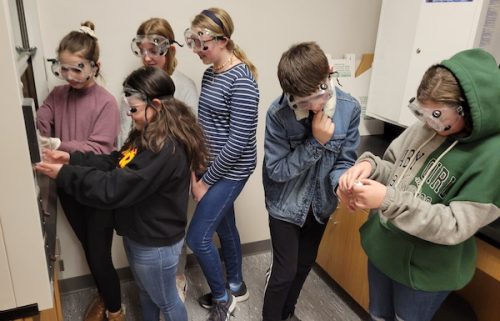
Team ‘Penicillium Mold Agar Consumption in Microgravity'” from Burleson, Texas works together to ensure measurements for their mini lab are the right proportions.
Proposal Summary:
Penicillium mold has been grown in microgravity before, therefore scientists know that penicillium can be grown on the International Space Station. What the experiment is intending on finding out is if mold grown in microgravity needs more nutrients or less. This could lead to the question: do astronauts need more nutrients or less than what the average person would need? The project will take potato dextrose agar and a penicillium mold stock culture with a small amount of water and let it grow; in the International Space Station, the astronauts will unclamp the clip and shake the FME gently, mixing in formaldehyde that was stored in a separate volume of the FME. Once this is completed it will be stored in a cooling unit until the return of the project. When the FME arrives, students will measure the differences between the two and compare the amount of agar that remains in the two tubes. If there is a noticeable difference between the amounts of agar remaining in each FME, this would indicate that the molds required different amounts of nutrition to grow. This could indicate that microgravity plays an important role in the nutritional value of food.
HONORABLE MENTION FINALISTS:
The Effect of Microgravity on Lion’s Mane Mushrooms
Grade 6, Nick Kerr Middle School
Co-Principal Investigators: Liana Aebischer, Ashlyn Favors, Dillyn LaRue, Elizabeth Meyer
Teacher Facilitator: Jonathan Hawley-Bernardez
Proposal Summary:
Our experiment question is, “How microgravity will affect the mass, structure, and the growth rate of the lion’s mane mushroom?” We know that microgravity makes bacteria grow faster and it can become dangerous, so will lion’s mane mushroom be affected in the same ways? Instead of becoming more dangerous, they might become more effective because the mushroom does not have any down sides; it has a lot of benefits that could help medical research. If it grows more efficiently, then maybe other fungi or plants like it may grow the same, so astronauts will not have to ship food with them – they can make fresh food. The project will be done by putting a stopper in the FME, then putting wheat bran and hardwood sawdust in the tube. Next, put a cut piece of lion’s mane mushroom in and the water after. After that, put the clamp and the formaldehyde in and then seal it with a stopper. Refrigerate the FME on the way up so the mushroom does not start growing until it reaches the International Space Station, where it will thaw and cultivate; we hypothesize that it will grow bigger than it would on Earth. When it is ready to return, the astronauts will unclamp and shake the FME to mix the formaldehyde in. When it returns put it on a tray and compare the one that went to space and the one that stayed on Earth to see if there is a size difference.
PETase Breakdown of Plastic in Microgravity
Grade 6, Nick Kerr Middle School
Co-Principal Investigators: Holden Jones, Kaden Jurica, Ava Mitchell, SaNiyah Nation
Teacher Facilitator: Allison Buckingham
Proposal Summary:
PET, polyethylene terephthalate, is the most frequently used plastic in our day to day lives. Our project involves introducing a plastic-eating enzyme known as PETase into space. If PETase can break down PET in a matter of days in microgravity, as PETase can on Earth, this could change the ways astronauts dispose of their plastic in space forever. There is an uncountable amount of plastic waste in our world and revolving around it. PETase would be very beneficial in eliminating the accumulation around the planet. The PETase starts by breaking down the polyethylene terephthalate into tiny pieces through ingestion. These tiny pieces turn into acid, upon which PETase then feeds. PETase comes from a type of mushroom called Pestalotiopsis Microspora.This enzyme isn’t harmful to humans or animals, which is one of the reasons we chose PETase. PETase will allow us to remove the plastic in microgravity without killing organisms. If PETase gets rid of the plastic in space, satellites will not be hit, allowing radio signals to travel smoother.
The FME type 2 is made out of silicone and PETase is only able to break down PET, which is not the same material. The enzyme can survive in refrigerated and ambient conditions. The temperature difference between the PETase’s optimal temperature and the temperature on the ISS has a slight temperature difference. The PETase may react slower than when experimented with on Earth, but should still be strong enough to break down the 5 grams of PET.
19. Ector County, Texas
Jump to Ector County’s Community Profile
SELECTED FOR FLIGHT:
Effects of Microgravity on formation of Serratia marcescens Biofilm
Grade 12, Permian High School
Principal Investigator: Swetha Kesavan
Teacher Facilitator: Gregorio Barajas
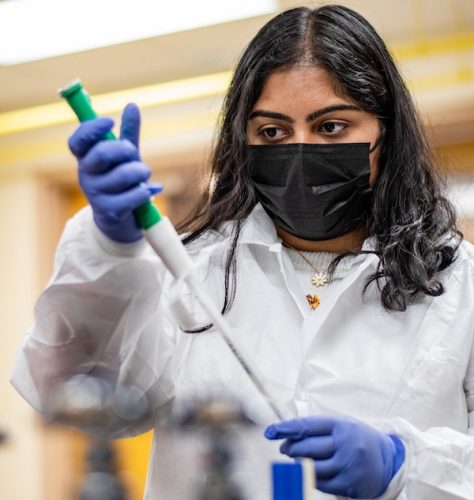
Swetha Kesavan carefully measures the correct volume of a chemical that will be loaded into the Fluids Mixing Enclosure to test the effects of microgravity on the formation of Serratia marcescens biofilm.”
Proposal Summary:
The goal of SSEP project is to determine the effects of microgravity on biofilm formation. Biofilms are a community of one or more types of microorganisms that can grow on different surfaces. The bacterium that is being investigated to create a biofilm is Serratia marcescens. Serratia marcescens is a bacterium that occurs naturally in soil and water and produces red color pigment at room temperature, different from other types of bacteria. Serratia marcescens can cause healthcare associated infections and antimicrobial resistance. This bacterium is also abundant in damp environments. However, the bacteria sample of Serratia marcescens that the investigation will be using is non- pathogenic and BSL-1 Safety Level so that there is no opportunity of infection. The growth medium used is nutrient broth that enables proliferation of the bacterium, Serratia marcescens. Once the growth the initiated, it is left to grow for a week. After that time, the fixative glutaraldehyde is added to stop the growth of the biofilm. It is important to identity a specific bacterium to send to the International Space Station to see if it poses a potential threat for life in space and how harmful can the bacteria become. Sending Serratia marcescens provides the ability for astronauts in space and researchers on Earth to visually detect the differences in the development of bacterium in space and Earth. The purpose of this project is to study the effects of microgravity on the mass, thickness, and morphology of Serratia marcescens.
HONORABLE MENTION FINALISTS:
What will be the Effect of Microgravity in the Reaction of Calcium and Citric Acid?
Grades 7 and 8, Nimitz Middle School
Co-Principal Investigators: Ava Alderson, Miguel Inigues, Zoey Terrazas
Teacher Facilitator: Dr. Azul Purcell
Proposal Summary:
The team is testing the effects of microgravity in the reaction of calcium and acid. Primarily, what we want to learn is, if the calcium reacts the same way with the mild acid as when it reacts with the gastric acid. We will analyze the effects of the gastric acid and how it breaks down calcium in the stomach. The team wants to address the fact that astronauts might have poor absorption due to the effects of microgravity. The team has researched the different acids and their effects in microgravity. With their similarities and differences to our stomach acids and availability to us, we have decided to choose citric acid for the first part. The team discovered that the citric acid is the closest acid, the team had to use the gastric to replace it. The team wants to use the similar materials to represent the actual reactants and with that we hope to discover if our inference was correct, which is : is the reaction of acids and calcium beneficial for our digestion? Does it help our diet? What we have discovered was that Calcium carbonate may cause acid rebound where the stomach overcompensates for the high dose of calcium carbonate. In other words calcium lowers and neutralizes the amount of acid you have in your stomach.Citric acid plays a role in calcium that may increase the absorption of the minerals calcium and phosphorus. Citric acid enhances the bioavailability of minerals, allowing your body to better absorb them. We hope that this experiment yields promising results.
Tardigrade Reproductive Rates in Microgravity
Grade 7, Nimitz Middle School
Co-Principal Investigators: Kimberly Espinoza, Mohammed Rehan, Mateo Sanchez
Teacher Facilitator: Dr. Azul Purcell
Proposal Summary:
It is very important that one day, if mankind tries to colonize other planets, which seems more and more possible everyday, that scientist knows everything about the effects of microgravity beforehand. That is why this team will be testing the reproduction rates in tardigrades. By testing the effects of microgravity on tardigrades, the beginning point for other organisms could be found in case while in space. This team chose tardigrades because this team knows from previous research that they are able to survive in space, and also this team finds them very fascinating organisms. This team will use a two compartment FME mini lab: in one compartment the tardigrades will be placed and on the other one the activator to take the tardigrades out of hibernation, and a way to exterminate the tardigrades when they will be sent back to Earth. After they are returned to Earth this team will observe how the tardigrades have multiplied compared to the tardigrades on Earth using a microscope.
20. Texarkana, Texas
Jump to Texarkana’s Community Profile
SELECTED FOR FLIGHT:
The Effects of Space Travel and Microgravity on Hybrid Brine Shrimp Eggs
Grade 6, Texas Middle School
Principal Investigator: Rivers Glass
Co-Investigators: Tiffany Bowen, Jayden Rios
Teacher Facilitator: Marcy Kelly
Proposal Summary:
Sea Monkeys have been a popular, and a somewhat unconventional, pet since the 1960’s. Commonly used as fish food and eventually sold in a commercialized kit, marketed as a novelty pet, Sea Monkeys are an unusual species. Sea Monkeys are a hybrid brine shrimp called Artemia NYOS and were invented in 1957 by Harold von Braunhut. Sea Monkeys are unique in that the eggs of the Sea Monkey come in a type of freeze dried state called “cryptobiosis”. In this state they are able to withstand harsh conditions such as the postal service and a variety of weather conditions. Once the Sea Monkey eggs are poured into purified water they come to life. The proposed investigation will be to determine whether Sea Monkey eggs can withstand the conditions of space travel as well as microgravity on the ISS. Understanding the durability and sustainability of this species of brine shrimp will benefit future missions in possibly offering a food source for longer missions. The success of this investigation will lead to experimenting with different varieties of invertebrates such as other species of shrimp, muscles, and clams.
HONORABLE MENTION FINALISTS:
What are the Effects of Microgravity on the Growth of a Fragaria x ananassa Seedling?
Grade 7, Texas Middle School
Co-Principal Investigators: Laney Russ, Emma Kate Taylor, Reese White, Mackenzie Wiley
Teacher Facilitator: Amanda Petty
Proposal Summary:
On Earth, gravity plays an important role in the growth of plants when they are just seedlings. Gravity helps to orient the seedling so that the stem grows toward the Sun which is the opposite direction of the pull of gravity. This is important because it is helping to position the plant’s leaves so they can best absorb light energy as the plant grows. Gravity also plays a role in helping the roots to grow toward the pull of gravity which helps to anchor the plant in the soil so that it doesn’t move. In a microgravity environment, such as onboard the International Space Station orbiting around the Earth, the effects of gravity are reduced. This is because objects inside the space station are travelling at the same rate as the space station is moving in Earth’s orbit. On Earth, this reduction in gravity would affect seedling growth because the plant needs gravity to help it know which direction to grow. This experiment will examine the effect of microgravity on the growth of a Fragaria x ananassa seedling also known as a strawberry plant. It is hypothesized that limited gravity will prevent the strawberry seedling from growing at the same rate as it would on Earth because the direction of growth is not being helped by gravity.
Effects of Microgravity on the Crystallization of Perovskite Solar Cells
Grade 8, Texas Middle School
Principal Investigator: Lili LeFors
Investigator: Catie Loomis
Collaborators: Maya Olson, Devine Portlock
Teacher Facilitator: Emily Burns
Proposal Summary:
The purpose of this experiment is to test the effectiveness of crystallization of perovskite solar cells in a microgravity environment. The premise of this experiment is that the perovskite would be made ready to grow, it would be grown in space, uninfluenced by the stern boundaries of gravity, and the way it is grown may determine the efficiency of detecting gamma rays. It has been proven that crystals grown in microgravity are larger and structured better.
21. Bellingham, Washington
Jump to Bellingham’s Community Profile
SELECTED FOR FLIGHT:
Germination of the Oplopanax Horridus (Devil’s Club) in a Microgravitational Environment
Grade 10, Lummi Nation School
Co-Principal Investigators: Tony K. Cline, Kaylee R. Morris, Keyonee C. Morris, Serena-Jo N. Pantalia, Dominic A. Solomon, Maddison P. Wilson
Teacher Facilitator: Riley H. Thuleen
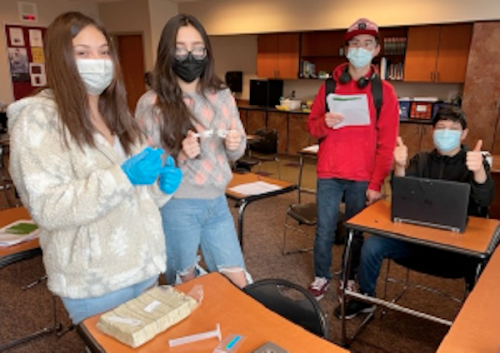
Assembling the FME in preparation for flight, and researching the germination requirements for Oplopanax horridus. From L to R: SerenaJo Pantalia, Kaylee Morris, Tony Cline, and Dominic Solomon.
Proposal Summary:
The experiment will consist of the seeds of an Oplopanax Horridus (Devil’s Club) being introduced to distilled water in microgravity in order to observe if the seed will germinate and sprout. This will indicate if the Oplopanax Horridus has a possibility to grow to its full extent in a microgravitational environment in later experiments. Devil’s Club could be used in the future is a medicinal healing, antibacterial agent for the treatment of minor injuries of space station astronauts and crew members as well as serving positive spiritual and cultural purposes for others. Once grown, it could be utilized as a renewable source of medicine.
HONORABLE MENTION FINALISTS:
Will Microgravity Affect Osmosis?
Grades 5 and 6, Lummi Nation School
Co-Principal Investigators: Starrlette Büßer-Hill, Lanhiya Jackson, Ariahlynn Joe, Mya Joe, Malina Morris, Olga-Ariela Kapuni-Lopez
Teacher Facilitator: Gary Brandt
Proposal Summary:
If microgravity does not interfere with osmosis, then water can be purified for astronauts’ use. Osmosis is the spontaneous passage or diffusion of water or other solvents through a semipermeable membrane which is a layer that only certain molecules can pass through. Taking advantage of the osmosis process, water can be filtered and purified which can provide a drinkable source of water while exploring other planets, moons, or asteroids that may have water or ice on them. For example, Earth’s moon has ice all over its surface as well as in craters. Being able to turn that ice into drinkable water would save space and fuel on any trip.
Germination of Solanum Lycopersicum in Microgravity
Grades 9 and 12, Lummi Nation School
Co-Principal Investigators: River Jones, Theo Solomon
Collaborators: Jayden Cano, Daimon Rosario, Caleb Tom
Teacher Facilitator: Riley H. Thuleen
Proposal Summary:
In a future in which mankind explores deeper and deeper into space and seeks to establish life on other planets, it will be critical for us to bring along nutritious foods that will help to sustain human life and happiness. In our world today, tomatoes, Solanum Lycopersicum, are foundational to healthy diets and foods that bring people great joy. Understanding whether we will be able to grow tomatoes in microgravity is an important step in understanding what life could be like in an interstellar future.
22. iForward-Grantsburg, Wisconsin
Jump to iForward-Grantsburg’s Community Profile
SELECTED FOR FLIGHT:
Growing and Glowing Mushrooms in Microgravity
Grade 6, iForward Public Online Charter School
Co-Principal Investigators: Kai Carter-Fisher, Kassandra Hall, Penya Richards, Rayne Saliger, Raishaun Sheridan
Teacher Facilitator: Andrea Konrath
Proposal Summary:
We hope to grow Panellus stipticus in microgravity. We would like to see if this species of bioluminescent mushrooms can thrive and glow as luminescent as they do on Earth. These mushrooms could be beneficial to astronauts, as they have been utilized for medical purposes, and if these fungi grow successfully, they could be used for future colonies on planets. According to the website, Science Daily, scientist Fydor Kondrashov states, “If we think of sci-fi scenarios in which glowing plants replace street lights — this is it. This is the breakthrough that can lead to this” (Scientists Discovered et. al., 2018). Just as these mushrooms provide light on Earth, a bigger impact could be made in space. We will use a type 3 FME tube with the first section filled with 2.8 ml of water. The second section will have ¼ tsp Panellus stipticus spawn and ¼ tsp compost. The third section will hold 2.8 ml of formaldehyde. Within the first week the astronauts will unclamp Clamp A and gently shake for 3 seconds, Then on U-5, the astronauts will need to unclamp Clamp B and shake for 5 seconds, preserving the fungi’s growth until it can be observed and compared on Earth. Our hypothesis is bioluminescent mushrooms can survive, grow, and glow in space. If they do, they could be a natural light source for future settlements on planets like Mars.
HONORABLE MENTION FINALISTS:
Ethanol Fermentation in Microgravity
Grade 9, iForward Public Online Charter School
Co-Principal Investigators: Paxtin Berndt, Ella George, Valeria Gonzalez, Victoria Sparks
Teacher Facilitator: Mark Dilley
Proposal Summary:
How will ethanol fermentation be affected in microgravity? The question stated is what the experiment will be trying to answer. This experiment will require yeast, sugar, and water. The first thing that will go in the FME is water, then a clamp, then yeast, and sugar. Test trials have been run of this experiment on the ground to do some basic analysis and observation of the process. The reaction began very quickly and after only a few minutes a drastic change was visible in the number of bubbles produced. It is expected the same will happen with the sample on the ground when the official experiment is being conducted and while in orbit. The experiment outcome that is most likely to occur is that the reaction will be bigger in orbit due to the lack of oxygen in the FME.
The Effects of Microgravity on the Growth of Brassica juncea
Grade 9, iForward Public Online Charter School
Co-Principal Investigators: Darwon Johnson, Katelynn Knuteson, Chloe Rabideau, Autumn Stein
Teacher Facilitator: Ryan Walsh
Proposal Summary:
Did you know that the direction of growth of the mustard seed is unregulated in microgravity (“JAXA | How Do Plants Grow in Microgravity?”)? For our experiment, we chose to explore the effects that microgravity has on mustard seeds. This assessment is crucial because it could be used for important research in the future, and it can also be used for future experiments. We decided to conduct our experiment by using a type 3 FME tube. Our demonstration works by starting the experiment once it is already in microgravity and stopping it before it undocks from the ISS. To start it, the seeds need to be germinated by the water, and to stop, we release a fixative that preserves our experiment so that we can observe what happens in microgravity and only microgravity. We also have a controlled experiment on earth to compare our orbital experiment to and observe any differences or changes in the growth. We plan to observe our experiment using numerous tools, like a microscope. We also could be using a scale to compare their masses, and measuring tools to see the change in height and speed of growth. These tools will help us to conclude our experiment. Using these tools we hope to see the effects that microgravity has on the mustard seeds. We are excited to see how microgravity affects the growth of mustard seeds, and how it could be important in the future.
